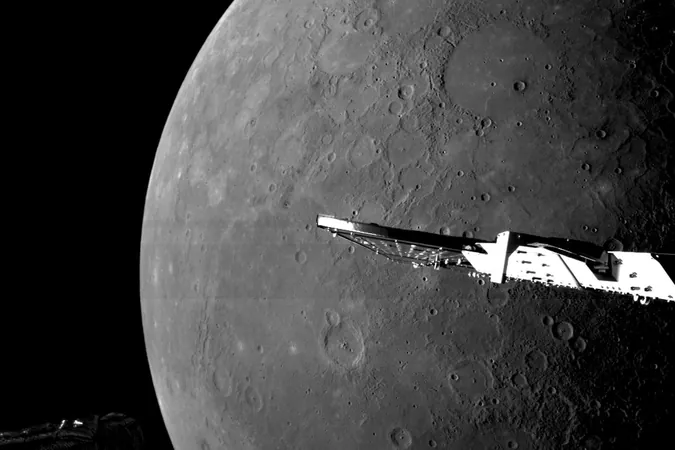
Eye-Popping Images Reveal the Secret Face of Mercury – What’s Hidden Beneath the Shadows?
2025-01-11
Author: Wei
BepiColombo's Groundbreaking Achievement
In a groundbreaking achievement, the BepiColombo spacecraft—a collaborative mission between Europe and Japan—has transmitted stunning close-up images of Mercury, the solar system’s innermost planet. This exceptional feat occurred during the spacecraft's sixth and final flyby on Wednesday, with the dual probes utilizing Mercury’s gravity to fine-tune their course for an orbital insertion slated for 2026.
The BepiColombo Mission
Launched in October 2018, BepiColombo consists of two interconnected spacecraft developed by the European Space Agency (ESA) and the Japan Aerospace Exploration Agency (JAXA). This marks a significant moment in the exploration of Mercury, which has remained a challenging target due to its proximity to the Sun and extreme temperatures.
Stunning Close-Up Images
During this latest flyby, the spacecraft approached within an astonishing distance of just 180 miles (295 kilometers) from the planet's surface. The images captured by BepiColombo provide an unprecedented look at Mercury’s crater-riddled landscape, beginning with its frigid, permanently dark night side situated near the north pole, before transitioning to the sunlit regions.
Mysteries of Mercury's Surface
One major highlight from the mission is the striking boundary between the illuminated and dark sides of the planet. Detailed imagery showcases the rims of notable craters such as Prokofiev, Kandinsky, Tolkien, and Gordimer, which may house hidden pockets of frozen water—a tantalizing prospect given Mercury's harsh, hot environment.
Uncovering Water and Geological History
A key objective of the BepiColombo mission is to uncover whether this mercurial world holds any water in its shadows, challenging our understanding of such a desolate planet. The impressive Caloris Basin, the largest impact crater on Mercury, dominates the lower-left quadrant of the visual data, stretching an incredible 930 miles (1,500 kilometers) in diameter.
Analyzing Geological Features
As the mission unfolds, scientists are piecing together Mercury's complicated geological history. The younger surface features appear noticeably brighter, while older materials gradually darken over time. Observations indicate that volcanic activity and large impacts have played crucial roles in shaping the surface. One striking feature, captured in a recent image, is the Nathair Facula, which represents the aftermath of a significant volcanic eruption, featuring a vent approximately 40 kilometers (25 miles) wide that has witnessed at least three major eruptions.
The Journey of BepiColombo
BepiColombo has now become only the third spacecraft, alongside Mariner 10 and MESSENGER, to ever visit Mercury—a feat made challenging by the Sun's immense gravitational forces. The mission’s two probes are designed to enter their respective orbits—ESA’s Mercury Planet Orbiter (MPO) and JAXA’s Mercury Magnetosphere Orbiter (MMO)—by late 2026. Since conducting its first flyby in October 2021, the spacecraft has been gathering invaluable data and capturing breathtaking images of the solar system's smallest planet.
Future Insights Await
“The main phase of BepiColombo's mission may not begin for another two years, but each of its six flybys has provided extraordinary insights into this little-explored planet,” stated Geraint Jones, BepiColombo’s project scientist at ESA. “In the coming weeks, our team will work diligently to unlock as many of Mercury's secrets as possible using the data obtained from this flyby.”
Intrigue Surrounding Mercury
As scientists continue to analyze the stunning images and data from BepiColombo, the intrigue surrounding Mercury only deepens. Will these hidden shadows reveal the presence of water, or perhaps even signs of volcanic activity? The answers await us in the upcoming explorations of this alluring planet. Don’t miss out on the latest revelations from Mercury; stay tuned for updates that could rewrite our understanding of this enigmatic world!




 Brasil (PT)
Brasil (PT)
 Canada (EN)
Canada (EN)
 Chile (ES)
Chile (ES)
 Česko (CS)
Česko (CS)
 대한민국 (KO)
대한민국 (KO)
 España (ES)
España (ES)
 France (FR)
France (FR)
 Hong Kong (EN)
Hong Kong (EN)
 Italia (IT)
Italia (IT)
 日本 (JA)
日本 (JA)
 Magyarország (HU)
Magyarország (HU)
 Norge (NO)
Norge (NO)
 Polska (PL)
Polska (PL)
 Schweiz (DE)
Schweiz (DE)
 Singapore (EN)
Singapore (EN)
 Sverige (SV)
Sverige (SV)
 Suomi (FI)
Suomi (FI)
 Türkiye (TR)
Türkiye (TR)
 الإمارات العربية المتحدة (AR)
الإمارات العربية المتحدة (AR)